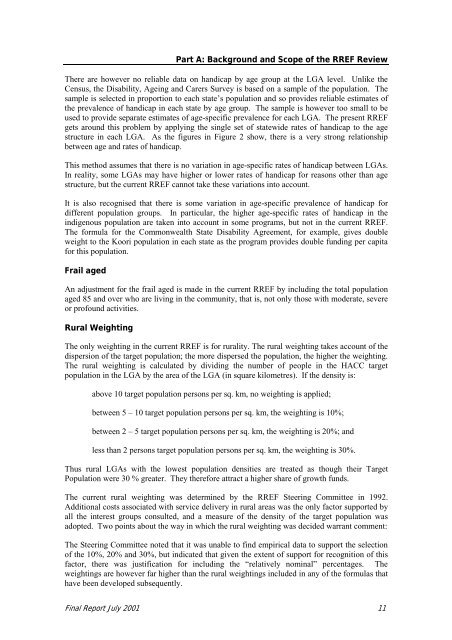Final Report on RREF 2001 - Department of Health
Final Report on RREF 2001 - Department of Health
Final Report on RREF 2001 - Department of Health
You also want an ePaper? Increase the reach of your titles
YUMPU automatically turns print PDFs into web optimized ePapers that Google loves.
Part A: Background and Scope <strong>of</strong> the <strong>RREF</strong> Review<br />
There are however no reliable data <strong>on</strong> handicap by age group at the LGA level. Unlike the<br />
Census, the Disability, Ageing and Carers Survey is based <strong>on</strong> a sample <strong>of</strong> the populati<strong>on</strong>. The<br />
sample is selected in proporti<strong>on</strong> to each state’s populati<strong>on</strong> and so provides reliable estimates <strong>of</strong><br />
the prevalence <strong>of</strong> handicap in each state by age group. The sample is however too small to be<br />
used to provide separate estimates <strong>of</strong> age-specific prevalence for each LGA. The present <strong>RREF</strong><br />
gets around this problem by applying the single set <strong>of</strong> statewide rates <strong>of</strong> handicap to the age<br />
structure in each LGA. As the figures in Figure 2 show, there is a very str<strong>on</strong>g relati<strong>on</strong>ship<br />
between age and rates <strong>of</strong> handicap.<br />
This method assumes that there is no variati<strong>on</strong> in age-specific rates <strong>of</strong> handicap between LGAs.<br />
In reality, some LGAs may have higher or lower rates <strong>of</strong> handicap for reas<strong>on</strong>s other than age<br />
structure, but the current <strong>RREF</strong> cannot take these variati<strong>on</strong>s into account.<br />
It is also recognised that there is some variati<strong>on</strong> in age-specific prevalence <strong>of</strong> handicap for<br />
different populati<strong>on</strong> groups. In particular, the higher age-specific rates <strong>of</strong> handicap in the<br />
indigenous populati<strong>on</strong> are taken into account in some programs, but not in the current <strong>RREF</strong>.<br />
The formula for the Comm<strong>on</strong>wealth State Disability Agreement, for example, gives double<br />
weight to the Koori populati<strong>on</strong> in each state as the program provides double funding per capita<br />
for this populati<strong>on</strong>.<br />
Frail aged<br />
An adjustment for the frail aged is made in the current <strong>RREF</strong> by including the total populati<strong>on</strong><br />
aged 85 and over who are living in the community, that is, not <strong>on</strong>ly those with moderate, severe<br />
or pr<strong>of</strong>ound activities.<br />
Rural Weighting<br />
The <strong>on</strong>ly weighting in the current <strong>RREF</strong> is for rurality. The rural weighting takes account <strong>of</strong> the<br />
dispersi<strong>on</strong> <strong>of</strong> the target populati<strong>on</strong>; the more dispersed the populati<strong>on</strong>, the higher the weighting.<br />
The rural weighting is calculated by dividing the number <strong>of</strong> people in the HACC target<br />
populati<strong>on</strong> in the LGA by the area <strong>of</strong> the LGA (in square kilometres). If the density is:<br />
above 10 target populati<strong>on</strong> pers<strong>on</strong>s per sq. km, no weighting is applied;<br />
between 5 – 10 target populati<strong>on</strong> pers<strong>on</strong>s per sq. km, the weighting is 10%;<br />
between 2 – 5 target populati<strong>on</strong> pers<strong>on</strong>s per sq. km, the weighting is 20%; and<br />
less than 2 pers<strong>on</strong>s target populati<strong>on</strong> pers<strong>on</strong>s per sq. km, the weighting is 30%.<br />
Thus rural LGAs with the lowest populati<strong>on</strong> densities are treated as though their Target<br />
Populati<strong>on</strong> were 30 % greater. They therefore attract a higher share <strong>of</strong> growth funds.<br />
The current rural weighting was determined by the <strong>RREF</strong> Steering Committee in 1992.<br />
Additi<strong>on</strong>al costs associated with service delivery in rural areas was the <strong>on</strong>ly factor supported by<br />
all the interest groups c<strong>on</strong>sulted, and a measure <strong>of</strong> the density <strong>of</strong> the target populati<strong>on</strong> was<br />
adopted. Two points about the way in which the rural weighting was decided warrant comment:<br />
The Steering Committee noted that it was unable to find empirical data to support the selecti<strong>on</strong><br />
<strong>of</strong> the 10%, 20% and 30%, but indicated that given the extent <strong>of</strong> support for recogniti<strong>on</strong> <strong>of</strong> this<br />
factor, there was justificati<strong>on</strong> for including the “relatively nominal” percentages. The<br />
weightings are however far higher than the rural weightings included in any <strong>of</strong> the formulas that<br />
have been developed subsequently.<br />
<str<strong>on</strong>g>Final</str<strong>on</strong>g> <str<strong>on</strong>g>Report</str<strong>on</strong>g> July <strong>2001</strong> 11
















